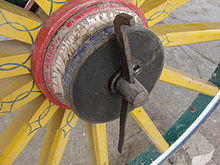A linchpin, also spelled linch pin, lynchpin, or lynch pin, is a fastener used to prevent a wheel or other part from sliding off the axle upon which it is riding. The word is first attested in the late fourteenth century and derives from Middle English elements meaning "axletree pin".[1][2]
Securing implements onto the three-point hitch of a tractor is an example of application. Linchpins may also be used in place of an R-clip for securing hitch pins.
Metaphorical use
The word "linchpin" is also used figuratively to mean "something [or someone] that holds the various elements of a complicated structure together".[3]
See also
- Circle cotter – Ring type of retaining component
- Circlip – Type of fastener or retaining ring
- Cotter (pin) – A pin or wedge passing through a hole to fix parts tightly together
- Hairpin clip
- R-clip – Type of fastener made of a springy material
- Split pin
- Spring pin
References
- ^ "linch-pin, n.". OED Online. June 2014. Oxford University Press. http://www.oed.com/view/Entry/108578 (accessed August 25, 2014; now behind paywall).
- ^ "linchpin (n.)". Online Etymology Dictionary. https://www.etymonline.com/word/linchpin (accessed 1 June 2018).
- ^ "Linchpin". Dictionary.reference.com. Retrieved 2012-03-24.
External links

